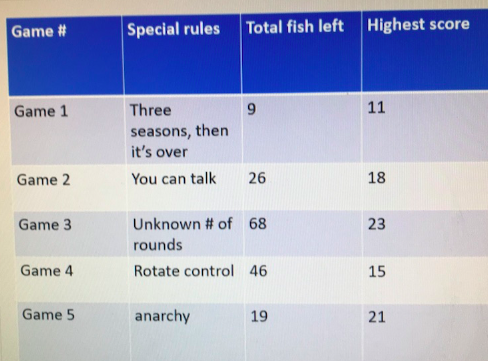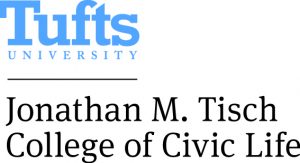Lesson plans can be found all over the Internet for games that model the “Tragedy of the Commons” using goldfish crackers. This is a version used in the Introduction to Civic Studies course at Tufts.
Materials: goldfish crackers (“fish”); plastic bowls (“lakes”); and forks (as tools for fishing).
Rules: Each group of four people should sit in a circle around its lake, which contains nine fish to start. Players “fish” by removing the goldfish from the bowl with a fork. All groups fish for 15 seconds while the instructor keeps time. Then students put down their forks and the fish “reproduce”: each fish left in the lake produces two offspring, up to a total population of 16, which is the carrying capacity of the lake. Then you repeat fishing for another season until either the seasons are over or the fish run out.
The facilitator should not explain the goal or what counts as winning, because that will vary in interesting ways.
Each round has different rules.
- Players play three seasons without talking at all.
- Players play three seasons and may talk before the game begins and during it.
- Each group plays an unannounced number of seasons before the facilitator stops them. They may talk.
- Players play three seasons silently, and each group rotates one fisher at a time. That person may spend as little or as much time as they like. As long as the player holds a fork, the others must wait.
- Players play using game 2 rules, except players may take fish from any table.
Results: The facilitator keeps track of the largest number of fish collected by any individual in each game and the number of fish left in the whole room at the end of each game.
Below are the results from a specific 52 Tufts undergraduates. Note that 68 fish were left when the number of seasons was unknown and students could talk. That is more than seven times more fish than survived in the first game, with a known number of seasons and no ability to communicate orally.

Questions for discussion:
- Did we observe “tragedies,” or not?
- When we did not, why not? What solutions did groups come up with?
- What were individuals trying to achieve? (Responses will likely vary: obtaining the most fish, trying to be fair, trying to look like nice people, learning by experimenting with different tactics.)
- Were your objectives affected by your perception of what other players were trying to achieve? (A norm can be understood as a shared sense of the goal.)
- What is the optimal solution? (Students should consider: maximizing the number of fish consumed, or the number of fish preserved at the end, and/or equity among the players. Other proposals may also emerge.)
- What parameters are included in the game? (Responses should include: attributes of the physical world; attributes of the community; official rules; and rules-in-use.)
- How realistic is the scenario? What is it a realistic model of?
- What assumptions does it make? How might those differ in reality? For instance, what if we played with $100 bills instead of Goldfish crackers?
- Why did everyone follow the instructor’s rules? Why not just grab the Goldfish?
- To what extent did additional rules emerge in practice? Is it realistic that people followed rules?
- In general, is it helpful to model a society using games? What assumptions does a game model make? (Selfishness?) What might a game not model well?
Related concepts
- Elinor OstromElinor Ostrom (1933-2012) was a political scientist at Indiana University and a leader of the intellectual movement informally known as the Bloomington School. She won the Nobel Prize in Economics in 2009 and was a MacArthur “genius” Fellow and president of the American Political Science Association. She directly influenced the development of Civic Studies. Contents … Continue reading
- Game theoryTo model a human interaction as a game means understanding it as a set of discrete choices made by independent parties that yield results for all (cf. Johnson 2020). A game model does not presume that the players choose privately or secretly. They may communicate and negotiate, but the game is ultimately decided by their … Continue reading
- PolycentrismVincent Ostrom, Charles Tiebout, and Robert Warren wrote that a “polycentric political system” exists when “many centers of decision- making which are formally independent of each other . . . take each other into account in competitive relationships, enter into various contractual and cooperative undertakings or have recourse to central mechanisms to resolve conflicts.” The … Continue reading
- Exit, Voice and LoyaltyIn Exit, Voice and Loyalty (1970), Albert O. Hirschman argues that people who are dissatisfied with groups of all kinds have two basic choices: Exit: Leaving the group. Then they do not have to put up with it or continue to be complicit in its actions. Exit is a human right. It can also improve … Continue reading
- Jürgen HabermasJürgen Habermas (1929-) is a German philosopher and sociologist, often seen as the leader of the intellectual movement called the “Frankfurt School” in its second generation, when he helped to shift it away from Marxism. He is often presented as a proponent and theorist of deliberative democracy, although he does not endorse all of the … Continue reading
- Elinor OstromElinor Ostrom (1933-2012) was a political scientist at Indiana University and a leader of the intellectual movement informally known as the Bloomington School. She won the Nobel Prize in Economics in 2009 and was a MacArthur “genius” Fellow and president of the American Political Science Association. She directly influenced the development of Civic Studies. Contents … Continue reading
- The Institutional Analysis and Design (IAD) FrameworkContents Concept As stated on the Ostrom Workshop website: The Institutional Analysis and Development (IAD) framework was designed by Ostrom and her colleagues from the Ostrom Workshop in 2005 to facilitate analysis of institution processes through which individual and collective choices occur. The IAD framework includes analyzing actors, norms, institutional settings, incentive structures, rules, and … Continue reading
- Design principles for commonsElinor Ostrom and colleagues have found that communities are more likely to succeed at producing and protecting common pool resources if they employ the principles listed below (as phrased in Levine 2022, drawing on E. Ostrom 1990 and E. Ostrom 2010, 653) For the underlying theory, see this video lecture by Peter Levine on Ostrom’s … Continue reading
- Social capital“Capital” always means something of value that produces a “flow” of goods for the one(s) who own it. For instance, a factory is physical capital. It can produce manufactured products if it is supplied with trained people (human capital) and raw materials. Social capital is unique in that it is not owned by an individual … Continue reading

